Robert Louis Stevenson
Robert Louis Stevenson (born Robert Lewis Balfour Stevenson; 13 November 1850 – 3 December 1894) was a Scottish novelist, poet and travel writer, most noted for Treasure Island, Kidnapped, Strange Case of Dr Jekyll and Mr Hyde, and A Child's Garden of Verses.
Robert Louis Stevenson | |
|---|---|
 Portrait by Henry Walter Barnett, 1893 | |
| Born | Robert Lewis Balfour Stevenson 13 November 1850 Edinburgh, Scotland |
| Died | 3 December 1894 (aged 44) Vailima, Samoa |
| Occupation | Novelist, poet, travel writer |
| Nationality | Scottish |
| Citizenship | United Kingdom |
| Education | 1857 Mr. Henderson's School, Edinburgh 1857 Private tutors 1859 Return to Mr. Henderson's School 1861 Edinburgh Academy 1863 Boarding school in Isleworth, Middlesex 1864 Robert Thomson's School, Edinburgh 1867 University of Edinburgh |
| Period | Victorian era |
| Notable works | Treasure Island A Child's Garden of Verses Kidnapped Strange Case of Dr Jekyll and Mr Hyde |
| Spouse | Fanny Van de Grift Osbourne
( m. 1880–1894) |
| Relatives | Thomas Stevenson (father) Margaret Isabella Balfour (mother) |
Born and educated in Edinburgh, Stevenson suffered from serious bronchial trouble for much of his life, but continued to write prolifically and travel widely in defiance of his poor health. As a young man, he mixed in London literary circles, receiving encouragement from Andrew Lang, Edmund Gosse, Leslie Stephen and W. E. Henley, the last of whom may have provided the model for Long John Silver in Treasure Island. In 1890, he settled in Samoa, where he died in 1894.[1]
A celebrity in his lifetime, Stevenson's critical reputation has fluctuated since his death, though today his works are held in general acclaim. He is currently ranked as the 26th most translated author in the world.
Life
Childhood and youth

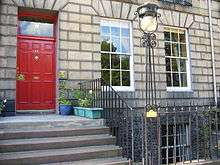
Stevenson was born at 8 Howard Place, Edinburgh, Scotland on 13 November 1850 to Thomas Stevenson (1818–1887), a leading lighthouse engineer, and his wife Margaret Isabella (born Balfour, 1829–1897). He was christened Robert Lewis Balfour Stevenson. At about age 18, he changed the spelling of "Lewis" to "Louis", and he dropped "Balfour" in 1873.[2][3]
Lighthouse design was the family's profession; Thomas's father (Robert's grandfather) was civil engineer Robert Stevenson, and Thomas's brothers (Robert's uncles) Alan and David were in the same field.[4] Thomas's maternal grandfather Thomas Smith had been in the same profession. However, Robert's mother's family were gentry, tracing their lineage back to Alexander Balfour who had held the lands of Inchyra in Fife in the fifteenth century. His mother's father Lewis Balfour (1777–1860) was a minister of the Church of Scotland at nearby Colinton,[5] and her siblings included physician George William Balfour and marine engineer James Balfour. Stevenson spent the greater part of his boyhood holidays in his maternal grandfather's house. "Now I often wonder what I inherited from this old minister," Stevenson wrote. "I must suppose, indeed, that he was fond of preaching sermons, and so am I, though I never heard it maintained that either of us loved to hear them."[6]
Lewis Balfour and his daughter both had weak chests, so they often needed to stay in warmer climates for their health. Stevenson inherited a tendency to coughs and fevers, exacerbated when the family moved to a damp, chilly house at 1 Inverleith Terrace in 1851.[7] The family moved again to the sunnier 17 Heriot Row when Stevenson was six years old, but the tendency to extreme sickness in winter remained with him until he was 11. Illness was a recurrent feature of his adult life and left him extraordinarily thin.[8] Contemporaneous views were that he had tuberculosis, but more recent views are that it was bronchiectasis[9] or even sarcoidosis.[10]
Stevenson's parents were both devout Presbyterians, but the household was not strict in its adherence to Calvinist principles. His nurse Alison Cunningham (known as Cummy)[11] was more fervently religious. Her mix of Calvinism and folk beliefs were an early source of nightmares for the child, and he showed a precocious concern for religion.[12] But she also cared for him tenderly in illness, reading to him from John Bunyan and the Bible as he lay sick in bed and telling tales of the Covenanters. Stevenson recalled this time of sickness in "The Land of Counterpane" in A Child's Garden of Verses (1885),[13] dedicating the book to his nurse.[14]
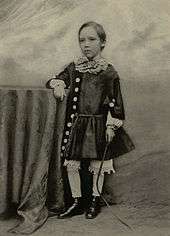
Stevenson was an only child, both strange-looking and eccentric, and he found it hard to fit in when he was sent to a nearby school at age 6, a problem repeated at age 11 when he went on to the Edinburgh Academy; but he mixed well in lively games with his cousins in summer holidays at Colinton.[15] His frequent illnesses often kept him away from his first school, so he was taught for long stretches by private tutors. He was a late reader, learning at age 7 or 8, but even before this he dictated stories to his mother and nurse,[16] and he compulsively wrote stories throughout his childhood. His father was proud of this interest; he had also written stories in his spare time until his own father found them and told him to "give up such nonsense and mind your business."[4] He paid for the printing of Robert's first publication at 16, entitled The Pentland Rising: A Page of History, 1666. It was an account of the Covenanters' rebellion which was published in 1866, the 200th anniversary of the event.[17]
Education
In September 1857, Stevenson went to Mr Henderson's School in India Street, Edinburgh, but because of poor health stayed only a few weeks and did not return until October 1859. During his many absences, he was taught by private tutors. In October 1861, he went to Edinburgh Academy, an independent school for boys, and stayed there sporadically for about fifteen months. In the autumn of 1863, he spent one term at an English boarding school at Spring Grove in Isleworth in Middlesex (now an urban area of West London). In October 1864, following an improvement to his health, he was sent to Robert Thomson's private school in Frederick Street, Edinburgh, where he remained until he went to university.[18] In November 1867, Stevenson entered the University of Edinburgh to study engineering. He showed from the start no enthusiasm for his studies and devoted much energy to avoiding lectures. This time was more important for the friendships he made with other students in the Speculative Society (an exclusive debating club), particularly with Charles Baxter, who would become Stevenson's financial agent, and with a professor, Fleeming Jenkin, whose house staged amateur drama in which Stevenson took part, and whose biography he would later write.[19] Perhaps most important at this point in his life was a cousin, Robert Alan Mowbray Stevenson (known as "Bob"), a lively and light-hearted young man who, instead of the family profession, had chosen to study art.[20]
Each year during vacations, Stevenson travelled to inspect the family's engineering works—to Anstruther and Wick in 1868, with his father on his official tour of Orkney and Shetland islands lighthouses in 1869, and for three weeks to the island of Erraid in 1870. He enjoyed the travels more for the material they gave for his writing than for any engineering interest. The voyage with his father pleased him because a similar journey of Walter Scott with Robert Stevenson had provided the inspiration for Scott's 1822 novel The Pirate.[21] In April 1871, Stevenson notified his father of his decision to pursue a life of letters. Though the elder Stevenson was naturally disappointed, the surprise cannot have been great, and Stevenson's mother reported that he was "wonderfully resigned" to his son's choice. To provide some security, it was agreed that Stevenson should read Law (again at Edinburgh University) and be called to the Scottish bar.[22] In his 1887 poetry collection Underwoods, Stevenson muses on his having turned from the family profession:[23]
Say not of me that weakly I declined
The labours of my sires, and fled the sea,
The towers we founded and the lamps we lit,
To play at home with paper like a child.
But rather say: In the afternoon of time
A strenuous family dusted from its hands
The sand of granite, and beholding far
Along the sounding coast its pyramids
And tall memorials catch the dying sun,
Smiled well content, and to this childish task
Around the fire addressed its evening hours.
In other respects too, Stevenson was moving away from his upbringing. His dress became more Bohemian; he already wore his hair long, but he now took to wearing a velveteen jacket and rarely attended parties in conventional evening dress.[24] Within the limits of a strict allowance, he visited cheap pubs and brothels.[25] More importantly, he had come to reject Christianity and declared himself an atheist.[26] In January 1873, his father came across the constitution of the LJR (Liberty, Justice, Reverence) Club, of which Stevenson and his cousin Bob were members, which began: "Disregard everything our parents have taught us". Questioning his son about his beliefs, he discovered the truth, leading to a long period of dissension with both parents:[27]
What a damned curse I am to my parents! As my father said, "You have rendered my whole life a failure". As my mother said, "This is the heaviest affliction that has ever befallen me". O Lord, what a pleasant thing it is to have damned the happiness of (probably) the only two people who care a damn about you in the world.
Early writing and travels
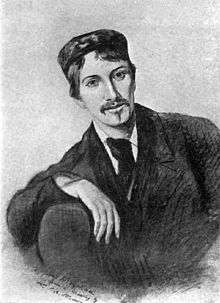
Stevenson was visiting a cousin in England in late 1873 when he met two people who became very important to him: Sidney Colvin and Fanny (Frances Jane) Sitwell. Sitwell was a 34-year-old woman with a son, who was separated from her husband. She attracted the devotion of many who met her, including Colvin, who married her in 1901. Stevenson was also drawn to her, and they kept up a warm correspondence over several years in which he wavered between the role of a suitor and a son (he addressed her as "Madonna").[28] Colvin became Stevenson's literary adviser and was the first editor of his letters after his death. He placed Stevenson's first paid contribution in The Portfolio, an essay entitled "Roads".[29]
Stevenson was soon active in London literary life, becoming acquainted with many of the writers of the time, including Andrew Lang, Edmund Gosse,[30] and Leslie Stephen, the editor of the Cornhill Magazine who took an interest in Stevenson's work. Stephen took Stevenson to visit a patient at the Edinburgh Infirmary named William Ernest Henley, an energetic and talkative man with a wooden leg. Henley became a close friend and occasional literary collaborator, until a quarrel broke up the friendship in 1888, and he is often considered to be the model for Long John Silver in Treasure Island.[31]
Stevenson was sent to Menton on the French Riviera in November 1873 to recuperate after his health failed. He returned in better health in April 1874 and settled down to his studies, but he returned to France several times after that.[32] He made long and frequent trips to the neighborhood of the Forest of Fontainebleau, staying at Barbizon, Grez-sur-Loing, and Nemours and becoming a member of the artists' colonies there. He also traveled to Paris to visit galleries and the theatres.[33] He qualified for the Scottish bar in July 1875, and his father added a brass plate to the Heriot Row house reading "R.L. Stevenson, Advocate". His law studies did influence his books, but he never practised law;[34] all his energies were spent in travel and writing. One of his journeys was a canoe voyage in Belgium and France with Sir Walter Simpson, a friend from the Speculative Society, a frequent travel companion, and the author of The Art of Golf (1887). This trip was the basis of his first travel book An Inland Voyage (1878).[35]
Marriage

The canoe voyage with Simpson brought Stevenson to Grez in September 1876 where he met Fanny Van de Grift Osbourne (1840–1914), born in Indianapolis. She had married at age 17 and moved to Nevada to rejoin husband Samuel after his participation in the American Civil War. Their children were Isobel (or "Belle"), Lloyd, and Hervey (who died in 1875). But anger over her husband's infidelities led to a number of separations. In 1875, she had taken her children to France where she and Isobel studied art.[36]
Stevenson returned to Britain shortly after this first meeting, but Fanny apparently remained in his thoughts, and he wrote the essay "On falling in love" for the Cornhill Magazine.[37] They met again early in 1877 and became lovers. Stevenson spent much of the following year with her and her children in France.[38] In August 1878, she returned to San Francisco and Stevenson remained in Europe, making the walking trip that formed the basis for Travels with a Donkey in the Cévennes (1879). But he set off to join her in August 1879, against the advice of his friends and without notifying his parents. He took second-class passage on the steamship Devonia, in part to save money but also to learn how others traveled and to increase the adventure of the journey.[39] He then traveled overland by train from New York City to California. He later wrote about the experience in The Amateur Emigrant. It was good experience for his writing, but it broke his health.
.jpg)
He was near death when he arrived in Monterey, California, where some local ranchers nursed him back to health. He stayed for a time at the French Hotel located at 530 Houston Street, now a museum dedicated to his memory called the "Stevenson House". While there, he often dined "on the cuff," as he said, at a nearby restaurant run by Frenchman Jules Simoneau, which stood at what is now Simoneau Plaza; several years later, he sent Simoneau an inscribed copy of his novel Strange Case of Dr Jekyll and Mr Hyde (1886), writing that it would be a stranger case still if Robert Louis Stevenson ever forgot Jules Simoneau. While in Monterey, he wrote an evocative article about "the Old Pacific Capital" of Monterey.
By December 1879, Stevenson had recovered his health enough to continue to San Francisco where he struggled "all alone on forty-five cents a day, and sometimes less, with quantities of hard work and many heavy thoughts,"[40] in an effort to support himself through his writing. But by the end of the winter, his health was broken again and he found himself at death's door. Fanny was now divorced and recovered from her own illness, and she came to his bedside and nursed him to recovery. "After a while," he wrote, "my spirit got up again in a divine frenzy, and has since kicked and spurred my vile body forward with great emphasis and success."[41] When his father heard of his condition, he cabled him money to help him through this period.
Fanny and Robert were married in May 1880, although he said that he was "a mere complication of cough and bones, much fitter for an emblem of mortality than a bridegroom."[42] He travelled with his new wife and her son Lloyd[43] north of San Francisco to Napa Valley and spent a summer honeymoon at an abandoned mining camp on Mount Saint Helena (today designated Robert Louis Stevenson State Park). He wrote about this experience in The Silverado Squatters. He met Charles Warren Stoddard, co-editor of the Overland Monthly and author of South Sea Idylls, who urged Stevenson to travel to the South Pacific, an idea which returned to him many years later. In August 1880, he sailed with Fanny and Lloyd from New York to Britain and found his parents and his friend Sidney Colvin on the wharf at Liverpool, happy to see him return home. Gradually, his wife was able to patch up differences between father and son and make herself a part of the family through her charm and wit.
Attempted settlement in Europe and the US
Stevenson searched in vain between 1880 and 1887 for a residence suitable to his health. He spent his summers at various places in Scotland and England, including Westbourne, Dorset, a residential area in Bournemouth. It was during his time in Bournemouth that he wrote the story Strange Case of Dr Jekyll and Mr Hyde, naming the character Mr. Poole after the town of Poole which is situated next to Bournemouth. In Westbourne, he named his house Skerryvore after the tallest lighthouse in Scotland, which his uncle Alan had built (1838–44). A novel of Stevenson's life while residing in Westbourne was written by Adelaide A. Boodle, who had met him there.[44] In the wintertime, Stevenson travelled to France and lived at Davos Platz and the Chalet de Solitude at Hyères, where he was very happy for a time. "I have so many things to make life sweet for me," he wrote, "it seems a pity I cannot have that other one thing—health. But though you will be angry to hear it, I believe, for myself at least, what is is best."[45] In spite of his ill health, he produced the bulk of his best-known work during these years. Treasure Island was published under the pseudonym "Captain George North" and became his first widely popular book; he wrote it during this time, along with Kidnapped, Strange Case of Dr Jekyll and Mr Hyde (which established his wider reputation), The Black Arrow: A Tale of the Two Roses, A Child's Garden of Verses, and Underwoods. He gave a copy of Kidnapped to his friend and frequent Skerryvore visitor Henry James.[46]
His father died in 1887 and Stevenson felt free to follow the advice of his physician to try a complete change of climate, so he headed for Colorado with his mother and family. But after landing in New York, they decided to spend the winter in the Adirondacks at a cure cottage now known as Stevenson Cottage at Saranac Lake, New York. During the intensely cold winter, Stevenson wrote some of his best essays, including Pulvis et Umbra. He also began The Master of Ballantrae and lightheartedly planned a cruise to the southern Pacific Ocean for the following summer.[47]
Politics
Stevenson believed in Conservatism for most of his life. His cousin and biographer Sir Graham Balfour said that "he probably throughout life would, if compelled to vote, have always supported the Conservative candidate."[48] In 1866, Stevenson voted for Benjamin Disraeli, future Conservative Prime Minister of the United Kingdom, over Thomas Carlyle for the Lord Rectorship of the University of Edinburgh.[49] During his college years, he briefly identified himself as a "red-hot socialist". He wrote at age 26: "I look back to the time when I was a Socialist with something like regret…. Now I know that in thus turning Conservative with years, I am going through the normal cycle of change and travelling in the common orbit of men's opinions."[50]
Journey to the Pacific




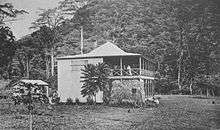


In June 1888, Stevenson chartered the yacht Casco and set sail with his family from San Francisco. The vessel "plowed her path of snow across the empty deep, far from all track of commerce, far from any hand of help."[51] The sea air and thrill of adventure for a time restored his health, and for nearly three years he wandered the eastern and central Pacific, stopping for extended stays at the Hawaiian Islands, where he became a good friend of King Kalākaua. He befriended the king's niece Princess Victoria Kaiulani, who also had Scottish heritage. He spent time at the Gilbert Islands, Tahiti, New Zealand, and the Samoan Islands. During this period, he completed The Master of Ballantrae, composed two ballads based on the legends of the islanders, and wrote The Bottle Imp. He preserved the experience of these years in his various letters and in his In the South Seas (which was published posthumously).[52] He made a voyage in 1889 with Lloyd on the trading schooner Equator, visiting Butaritari, Mariki, Apaiang, and Abemama in the Gilbert Islands.[53] They spent several months on Abemama with tyrant-chief Tem Binoka, whom Stevenson described in In the South Seas.[53]
Stevenson left Sydney, Australia, on the Janet Nicoll in April 1890 for his third and final voyage among the South Seas islands.[54] He intended to produce another book of travel writing to follow his earlier book In the South Seas, but it was his wife who eventually published her journal of their third voyage. (Fanny misnames the ship in her account The Cruise of the Janet Nichol.)[55] A fellow passenger was Jack Buckland, whose stories of life as an island trader became the inspiration for the character of Tommy Hadden in The Wrecker (1892), which Stevenson and Lloyd Osbourne wrote together.[56][57] Buckland visited the Stevensons at Vailima in 1894.[58]
Last years
In 1890, Stevenson purchased a tract of about 400 acres (1.6 km²) in Upolu, an island in Samoa where he established himself on his estate in the village of Vailima after two aborted attempts to visit Scotland. He took the native name Tusitala (Samoan for "Teller of Tales"). His influence spread among the Samoans, who consulted him for advice, and he soon became involved in local politics. He was convinced that the European officials who had been appointed to rule the Samoans were incompetent, and he published A Footnote to History after many futile attempts to resolve the matter. This was such a stinging protest against existing conditions that it resulted in the recall of two officials, and Stevenson feared for a time that it would result in his own deportation. He wrote to Colvin, "I used to think meanly of the plumber; but how he shines beside the politician!"[59]
He also found time to work at his writing, although he felt that "there was never any man had so many irons in the fire".[60] He wrote The Beach of Falesa, Catriona (titled David Balfour in the US),[61] The Ebb-Tide, and the Vailima Letters during this period.
Stevenson grew depressed and wondered if he had exhausted his creative vein, as he had been "overworked bitterly"[62] and that the best he could write was "ditch-water".[63] He even feared that he might again become a helpless invalid. He rebelled against this idea: "I wish to die in my boots; no more Land of Counterpane for me. To be drowned, to be shot, to be thrown from a horse — ay, to be hanged, rather than pass again through that slow dissolution."[64] He then suddenly had a return of energy and he began work on Weir of Hermiston. "It's so good that it frightens me," he is reported to have exclaimed.[65] He felt that this was the best work he had done.[66]
On 3 December 1894, Stevenson was talking to his wife and straining to open a bottle of wine when he suddenly exclaimed, "What's that?", asked his wife "does my face look strange?", and collapsed.[1] He died within a few hours, probably of a cerebral haemorrhage. He was 44 years old. The Samoans insisted on surrounding his body with a watch-guard during the night and on bearing him on their shoulders to nearby Mount Vaea, where they buried him on a spot overlooking the sea on land donated by British Acting Vice Consul Thomas Trood.[67] Stevenson had always wanted his Requiem inscribed on his tomb:[68]
- Under the wide and starry sky,
- Dig the grave and let me lie.
- Glad did I live and gladly die,
- And I laid me down with a will.
- This be the verse you grave for me:
- Here he lies where he longed to be;
- Home is the sailor, home from sea,
- And the hunter home from the hill.
Stevenson was loved by the Samoans, and his tombstone epigraph was translated to a Samoan song of grief.[69]
Modern reception
Half of Stevenson's original manuscripts are lost, including those of Treasure Island, The Black Arrow, and The Master of Ballantrae. His heirs sold his papers during World War I, and many Stevenson documents were auctioned off in 1918.[70]
Stevenson was a celebrity in his own time, being admired by many other writers, including Jorge Luis Borges, Bertolt Brecht, Marcel Proust, Arthur Conan Doyle, Henry James, Cesare Pavese, Emilio Salgari, Ernest Hemingway, Rudyard Kipling, Jack London, Vladimir Nabokov,[71] J. M. Barrie,[72] and G. K. Chesterton, who said that Stevenson "seemed to pick the right word up on the point of his pen, like a man playing spillikins."[73]
Stevenson was seen for much of the 20th century as a second-class writer. He became relegated to children's literature and horror genres,[74] condemned by literary figures such as Virginia Woolf (daughter of his early mentor Leslie Stephen) and her husband Leonard Woolf, and he was gradually excluded from the canon of literature taught in schools.[74] His exclusion reached its nadir in the 1973 2,000-page Oxford Anthology of English Literature where he was entirely unmentioned, and The Norton Anthology of English Literature excluded him from 1968 to 2000 (1st–7th editions), including him only in the 8th edition (2006).[74]
The late 20th century brought a re-evaluation of Stevenson as an artist of great range and insight, a literary theorist, an essayist and social critic, a witness to the colonial history of the Pacific Islands, and a humanist.[74] He was praised by Roger Lancelyn Green, one of the Oxford Inklings, as a writer of a consistently high level of "literary skill or sheer imaginative power" and a pioneer of the Age of the Story Tellers along with H. Rider Haggard.[75] He is now evaluated as a peer of authors such as Joseph Conrad (whom Stevenson influenced with his South Seas fiction) and Henry James, with new scholarly studies and organisations devoted to him.[74] Throughout the vicissitudes of his scholarly reception, Stevenson has remained popular worldwide. According to the Index Translationum, Stevenson is ranked the 26th most translated author in the world, ahead of Oscar Wilde and Edgar Allan Poe.[76]
On the subject of Stevenson's modern reputation, American film critic Roger Ebert wrote in 1996,
I was talking to a friend the other day who said he'd never met a child who liked reading Robert Louis Stevenson's Treasure Island.
Neither have I, I said. And he'd never met a child who liked reading Stevenson's Kidnapped. Me neither, I said. My early exposure to both books was via the Classics Illustrated comic books. But I did read the books later, when I was no longer a kid, and I enjoyed them enormously. Same goes for Stevenson's Dr. Jekyll and Mr. Hyde.
The fact is, Stevenson is a splendid writer of stories for adults, and he should be put on the same shelf with Joseph Conrad and Jack London instead of in between Winnie the Pooh and Peter Pan.[77]
Monuments and commemoration
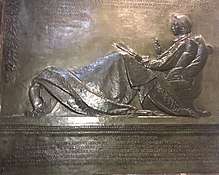
The Writers' Museum near Edinburgh's Royal Mile devotes a room to Stevenson, containing some of his personal possessions from childhood through to adulthood.
The Stevenson House at 530 Houston Street in Monterey, California, formerly the French Hotel, memorializes Stevenson's 1879 stay in "the Old Pacific Capital", as he was crossing the United States to join his future wife, Fanny Osbourne. The Stevenson House museum is graced with a bas-relief depicting the sickly author writing in bed.
The Robert Louis Stevenson Museum in St. Helena, California, is home to over 11,000 objects and artifacts, the majority of which belonged to Stevenson. Opened in 1969, the museum houses such treasures as his childhood rocking chair, writing desk, toy soldiers, and personal writings among many other items. The museum is free to the public and serves as an academic archive for students, writers, and Stevenson enthusiasts.
Stevenson's former home in Vailima, Samoa, is now a museum dedicated to the later years of his life. The museum collection includes several original items belonging to Stevenson and his family. The path to Stevenson's grave at the top of Mt Vaea commences from the museum.
A bronze relief memorial to Stevenson, designed by the American sculptor Augustus Saint-Gaudens in 1904, is mounted in the Moray Aisle of St Giles' Cathedral, Edinburgh.[78] Saint-Gaudens' scaled-down version of this relief is in the collection of the Montclair Art Museum.[79] Another small version depicting Stevenson with a cigarette in his hand rather than the pen he holds in the St. Giles memorial is displayed in the Nichols House Museum in Beacon Hill, Boston.[80]
Another memorial in Edinburgh stands in West Princes Street Gardens below Edinburgh Castle; it is a simple upright stone inscribed with "RLS – A Man of Letters 1850–1894" by sculptor Ian Hamilton Finlay in 1987.[81] In 2013, a statue of Stevenson as a child with his dog was unveiled by the author Ian Rankin outside Colinton Parish Church.[82] The sculptor of the statue was Alan Herriot, and the money to erect it was raised by the Colinton Community Conservation Trust.[82]
A plaque above the door of a house in Castleton of Braemar states "Here R.L. Stevenson spent the Summer of 1881 and wrote Treasure Island, his first great work".
A garden was designed by the Bournemouth Corporation in 1957 as a memorial to Stevenson, on the site of his Westbourne house, "Skerryvore", which he occupied from 1885 to 1887. A statue of the Skerryvore lighthouse is present on the site.
In 1966, the Canadian actor Lloyd Bochner played Stevenson in the episode "Jolly Roger and Wells Fargo" of the syndicated American television series, Death Valley Days, hosted by Robert Taylor and directed by Denver Pyle.[83] In an earlier Death Valley Days episode from 1958, "The Great Amulet", hosted by Stanley Andrews, the actor Don Reardon (died 2004) played the role of Stevenson. In the story line, Stevenson falls in love with Fanny Osbourne, played by Aline Towne (1919-1996), the mother of two children in a loveless marriage in San Francisco. The couple met in France where Stevenson was recuperating from health issues and moved to San Francisco, where Stevenson worked tirelessly despite lingering health matters in the production of his large volume of literary works. "The Great Amulet" is revealed at the conclusion of the episode.[84]
In 1994, to mark the 100th anniversary of Stevenson's death, the Royal Bank of Scotland issued a series of commemorative £1 notes which featured a quill pen and Stevenson's signature on the obverse, and Stevenson's face on the reverse side. Alongside Stevenson's portrait are scenes from some of his books and his house in Western Samoa.[85] Two million notes were issued, each with a serial number beginning "RLS". The first note to be printed was sent to Samoa in time for their centenary celebrations on 3 December 1994.[86]
At least six US elementary schools are named after Stevenson, in the Upper West Side of New York City,[87] in Fridley, Minnesota,[88] in Burbank, California,[89] in Grandview Heights, Ohio (suburb of Columbus), in San Francisco, California,[90] and in Merritt Island, Florida.[91] There is an R. L. Stevenson middle school in Honolulu, Hawaii and in Saint Helena, California. Stevenson School in Pebble Beach, California, was established in 1952 and still exists as a college preparatory boarding school. Robert Louis Stevenson State Park near Calistoga, California, contains the location where he and Fanny spent their honeymoon in 1880.[92]
A street in Honolulu's Waikiki District, where Stevenson lived while in the Hawaiian Islands, was named after his Samoan moniker: Tusitala.[93] This was also (until 2014) the name of a restaurant on Buckstone Terrace, Edinburgh on the route of a favourite walk that Stevenson often took to the village of Swanston in the Pentland Hills.[94][95]
In 2011, Stevenson's open letter defending Father Damien from Rev. Dr. Charles McEwen Hyde influenced the founding of the Saint Damien Advocates in Hawaii.[96]
The Chemin de Stevenson (GR 70) is a popular long-distance footpath in France that approximately follows Stevenson's route as described in Travels with a Donkey in the Cévennes. There are numerous monuments and businesses named after him along the route, including a fountain in the town of Saint-Jean-du-Gard where Stevenson sold his donkey Modestine and took a stagecoach to Alès.[97]
The Robert Louis Stevenson Memorial is an outdoor memorial in Portsmouth Square, San Francisco, California.
A memorial by Gutzon Borglum was unveiled, in 1915, at Baker Cottage, Saranac Lake, New York.
Gallery
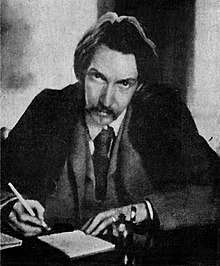 Stevenson in 1885
Stevenson in 1885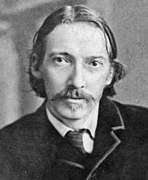 Photographic portrait, c. 1887
Photographic portrait, c. 1887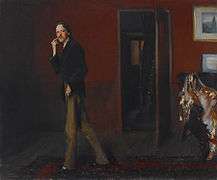 Stevenson paces in his dining room in an 1885 portrait by John Singer Sargent. His wife Fanny, seated in an Indian dress, is visible in the lower right corner.
Stevenson paces in his dining room in an 1885 portrait by John Singer Sargent. His wife Fanny, seated in an Indian dress, is visible in the lower right corner.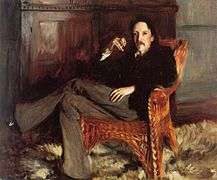 Portrait by John Singer Sargent, 1887
Portrait by John Singer Sargent, 1887- Portrait by William Blake Richmond, 1886
 Portrait by Girolamo Nerli, 1892
Portrait by Girolamo Nerli, 1892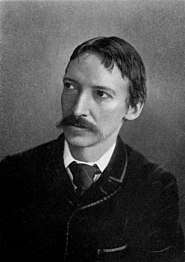 by Henry Walter Barnett, 1893
by Henry Walter Barnett, 1893
Bibliography
Novels
.jpg)
- The Hair Trunk or The Ideal Commonwealth (1877) Unfinished and unpublished.[98] An annotated edition of the original manuscript, edited and introduced by Roger G. Swearingen, was published as The Hair Trunk or The Ideal Commonwealth: An Extravaganza in August 2014.
- Treasure Island (1883) His first major success, a tale of piracy, buried treasure, and adventure, has been filmed frequently. In an 1881 letter to W. E. Henley, he provided the earliest known title, "The Sea Cook, or Treasure Island: a Story for Boys".
- Prince Otto (1885) Stevenson's third full-length narrative, an action romance set in the imaginary Germanic state of Grünewald.
- Strange Case of Dr Jekyll and Mr Hyde (1886), a novella about a dual personality much depicted in plays and films, also influential in the growth of understanding of the subconscious mind through its treatment of a kind and intelligent physician who turns into a psychopathic monster after imbibing a drug intended to separate good from evil in a personality.
- Kidnapped (1886) is a historical novel that tells of the boy David Balfour's pursuit of his inheritance and his alliance with Alan Breck Stewart in the intrigues of Jacobite troubles in Scotland.
- The Black Arrow: A Tale of the Two Roses (1888) An historical adventure novel and romance set during the Wars of the Roses.
- The Master of Ballantrae: A Winter's Tale (1889), a masterful tale of revenge, set in Scotland, America, and India.
- The Wrong Box (1889); co-written with Lloyd Osbourne. A comic novel of a tontine, also filmed (1966).
- The Wrecker (1892); co-written with Lloyd Osbourne.
- Catriona (1893), also known as David Balfour, is a sequel to Kidnapped, telling of Balfour's further adventures.
- The Ebb-Tide (1894); co-written with Lloyd Osbourne.
- Weir of Hermiston (1896). Unfinished at the time of Stevenson's death, considered to have promised great artistic growth.
- St Ives: Being the Adventures of a French Prisoner in England (1897). Unfinished at the time of Stevenson's death, the novel was completed by Arthur Quiller-Couch.
Short story collections
- New Arabian Nights (1882)
- More New Arabian Nights: The Dynamiter (1885); co-written with Fanny Van De Grift Stevenson
- The Merry Men and Other Tales and Fables (1887); contains 6 stories.
- Island Nights' Entertainments (also known as South Sea Tales) (1893) contains three longer stories.
- Fables (1896) contains 20 stories: "The Persons of the Tale", "The Sinking Ship", "The Two Matches", "The Sick Man and the Fireman", "The Devil and the Innkeeper", "The Penitent", "The Yellow Paint", "The House of Eld", "The Four Reformers", "The Man and His Friend", "The Reader", "The Citizen and the Traveller", "The Distinguished Stranger", "The Carthorse and the Saddlehorse", "The Tadpole and the Frog", "Something in It", "Faith, Half Faith and No Faith at All", "The Touchstone", "The Poor Thing", "The Song of the Morrow".
- Tales and Fantasies, 1905, contains The Story of a Lie, The Body Snatcher, The Misadventures of John Nicholson.
Short stories
List of short stories sorted chronologically. Note: does not include collaborations with Fanny found in More New Arabian Nights: The Dynamiter.
| Title | Date | Collection | Notes |
|---|---|---|---|
| "When the Devil was Well" | 1875 | 1921, Boston Bibliophile Society | |
| "An Old Song" | 1875 | Uncollected | Stevenson's first Published Fiction, in London, 1877. Anonymous. Republished in 1982 by R. Swearingen. |
| "Edifying Letters of the Rutherford Family" | 1877 | Unfinished, uncollected. | Not truly a short-story. First published in 1982 by R. Swearingen. |
| "Will O' the Mill" | 1877 | The Merry Men and Other Tales and Fables, 1887 | First published in the Cornhill Magazine, 1878 |
| "A Lodging for the Night" | 1877 | New Arabian Nights (1882) | First published in Temple Bar in 1877 |
| "The Sire De Malétroits Door" | 1877 | New Arabian Nights, 1882 | First published in Temple Bar in 1878 |
| "Later-day Arabian Nights" | 1878 | New Arabian Nights, 1882 | First published in London in 1878. Seven interconnected stories in two cycles: The Suicide Club (3 stories) and The Rajah's Diamond (4 stories). |
| "Providence and the Guitar" | 1878 | New Arabian Nights, 1882 | First published in London in 1878 |
| "The Story of a Lie" | 1879 | The Novels and Tales of Robert Louis Stevenson, vol 3, 1895 | First published in New Quarterly Magazine in 1879. |
| "The Pavilion on the Links" | 1880 | With a few suppressions in New Arabian Nights, 1882 | First Published in the Cornhill Magazine in 1880. Told in 9 mini-chapters. Conan Doyle in 1890 called it the first English short story. |
| "Thrawn Janet" | 1881 | The Merry Men and Other Tales and Fables, 1887 | First published in the Cornhill Magazine, 1881 |
| "The Body Snatcher" | 1881 | Edinburgh Edition, 1895 | First published in the Christmas 1884 edition of the Pall Mall Gazette. |
| "The Merry Men" | 1882 | With changes in The Merry Men and Other Tales and Fables, 1887 | First published in the Cornhill Magazine in 1882. |
| "The Treasure of Franchard" | 1883 | The Merry Men and Other Tales and Fables, 1887 | First published in Longman's Magazine, 1883 |
| "Markheim" | 1884 | The Merry Men and Other Tales and Fables, 1887 | First published in the Broken Shaft. Unwin's Annual., 1885 |
| "Strange Case of Dr Jekyll and Mr Hyde" | 1885 | 1886 | Variously referred to as a short story or novella, or more rarely, a short novel.[99] |
| "Olalla" | 1885 | The Merry Men and Other Tales and Fables, 1887 | First published in the Court and Society Review, 1885 |
| "The Misadventures of John Nicholson: A Christmas Story" | 1885–87 | Edinburgh Edition, 1897 | First published in Yule Tide, 1887 |
| "The Bottle Imp" | 1891 | Island Nights' Entertainments (1893) | First published in Black and White, 1891 |
| "The Beach of Falesá" | 1892 | Island Nights' Entertainments (1893) | First published in Illustrated London News in 1892 |
| "The Isle of Voices" | 1892 | Island Nights' Entertainments (1893) | First published in National Observer, 1883 |
| "The Waif Woman" | 1892 | 1914 | First published in the Scribner's Magazine, 1914 |
Non-fiction
- . Encyclopædia Britannica (11th ed.). 1911. — first published in the 9th edition (1875–1889).
- Virginibus Puerisque, and Other Papers (1881), contains the essays Virginibus Puerisque i (1876); Virginibus Puerisque ii (1881); Virginibus Puerisque iii: On Falling in Love (1877); Virginibus Puerisque iv: The Truth of Intercourse (1879); Crabbed Age and Youth (1878); An Apology for Idlers (1877); Ordered South (1874); Aes Triplex (1878); El Dorado (1878); The English Admirals (1878); Some Portraits by Raeburn (previously unpublished); Child's Play (1878); Walking Tours (1876); Pan's Pipes (1878); A Plea for Gas Lamps (1878).
- Familiar Studies of Men and Books (1882) containing Preface, by Way of Criticism (not previously published); Victor Hugo's Romances (1874); Some Aspects of Robert Burns (1879); The Gospel According to Walt Whitman (1878); Henry David Thoreau: His Character and Opinions (1880); Yoshida-Torajiro (1880); François Villon, Student, Poet, Housebreaker (1877); Charles of Orleans (1876); Samuel Pepys (1881); John Knox and his Relations to Women (1875).
- Memories and Portraits (1887), a collection of essays.
- On the Choice of a Profession (1887)
- Memoir of Fleeming Jenkin (1888)
- Father Damien: an Open Letter to the Rev. Dr. Hyde of Honolulu (1890)
- Vailima Letters (1895)
- Prayers Written at Vailima (1904)
- Essays in the Art of Writing (1905)
- The New Lighthouse on the Dhu Heartach Rock, Argyllshire (1995). Based on an 1872 manuscript, edited by R. G. Swearingen. California. Silverado Museum.
- Sophia Scarlet (2008). Based on an 1892 manuscript, edited by Robert Hoskins. AUT Media (AUT University).
Poetry
- A Child's Garden of Verses (1885), written for children but also popular with their parents. Includes such favourites as "My Shadow" and "The Lamplighter". Often thought to represent a positive reflection of the author's sickly childhood.
- Underwoods (1887), a collection of poetry written in both English and Scots.
- Ballads (1891), included Ticonderoga: A Legend of the West Highlands (1887). Based on a famous Scottish ghost story.
- Songs of Travel and Other Verses (1896)
- Poems Hitherto Unpublished, 3 vol. 1916, 1916, 1921, Boston Bibliophile Society, republished in New Poems
Plays
- Three Plays (1892), co-written with William Ernest Henley. Includes the theatre pieces Deacon Brodie, Beau Austin, and Admiral Guinea.
Travel writing
- An Inland Voyage (1878), travels with a friend in a Rob Roy canoe from Antwerp (Belgium) to Pontoise, just north of Paris.
- Edinburgh: Picturesque Notes (1878) - a paean to his birthplace, it provides Stevenson's personal introduction to each part of the city and some history behind the various sections of the city and its most famous buildings.
- Travels with a Donkey in the Cévennes (1879), two weeks' solo ramble (with Modestine as his beast of burden) in the mountains of Cévennes (south-central France), one of the first books to present hiking and camping as recreational activities. It tells of commissioning one of the first sleeping bags.
- The Silverado Squatters (1883). An unconventional honeymoon trip to an abandoned mining camp in Napa Valley with his new wife Fanny and her son Lloyd. He presciently identifies the California wine industry as one to be reckoned with.
- Across the Plains (written in 1879–80, published in 1892). Second leg of his journey, by train from New York to California (then picks up with The Silverado Squatters). Also includes other travel essays.
- The Amateur Emigrant (written 1879–80, published 1895). An account of the first leg of his journey to California, by ship from Europe to New York. Andrew Noble (From the Clyde to California: Robert Louis Stevenson's Emigrant Journey, 1985) considers it to be his finest work.
- The Old and New Pacific Capitals (1882). An account of his stay in Monterey, California in August to December 1879. Never published separately. See, for example, James D. Hart, ed., From Scotland to Silverado, 1966.
- Essays of Travel (London: Chatto & Windus, 1905)
Island literature
Although not well known, his island fiction and non-fiction is among the most valuable and collected of the 19th century body of work that addresses the Pacific area.
- In the South Seas (1896). A collection of Stevenson's articles and essays on his travels in the Pacific.
- A Footnote to History, Eight Years of Trouble in Samoa (1892).
See also
- Robert Louis Stevenson State Park
- People on Scottish banknotes
- Victorian literature
- Salvation Army Waiʻoli Tea Room (Robert Louis Stevenson Memorial Grass House on premises)
- Writers' Museum
References
- Balfour, Graham (1906). The Life of Robert Louis Stevenson London: Methuen. 264
- Mehew (2004). The spelling "Lewis" is said to have been rejected because his father violently disliked another person of the same name, and the new spelling was not accompanied by a change of pronunciation (Balfour (1901) I, 29 n. 1.
- Furnas (1952), 23–4; Mehew (2004)).
- Paxton (2004).
- Balfour (1901), 10–12; Furnas (1952), 24; Mehew (2004).
- Memories and Portraits (1887), Chapter VII. The Manse.
- "A Robert Louis Stevenson Timeline (born Nov. 13th 1850 in Edinburgh, died Dec. 3rd 1894 in Samoa)". Robert-louis-stevenson.org. Retrieved 14 May 2012.
- Furnas (1952), 25–8; Mehew (2004).
- Holmes, Lowell (2002). Treasured Islands: Cruising the South Seas with Robert Louis Stevenson. Sheridan House, Inc. ISBN 1-57409-130-1.
- Sharma OP (2005). "Murray Kornfeld, American College of Chest Physician, and sarcoidosis: a historical footnote: 2004 Murray Kornfeld Memorial Founders Lecture". Chest. 128 (3): 1830–35. doi:10.1378/chest.128.3.1830. PMID 16162793.
- "Stevenson's Nurse Dead: Alison Cunningham ("Cummy") lived to be over 91 years old" (PDF). The New York Times. 10 August 1913. p. 3.
- Furnas (1952), 28–32; Mehew (2004).
- Available at Bartleby and elsewhere.
- Furnas (1952), 29; Mehew (2004).
- Furnas (1952), 34–6; Mehew (2004). Alison Cunningham's recollection of Stevenson balances the picture of an oversensitive child, "like other bairns, whiles very naughty": Furnas (1952), 30.
- Mehew (2004).
- Balfour (1901) I, 67; Furnas (1952), pp. 43–45.
- Stephenson, Robert Louis (1850–1894) – Childhood and schooling. Oxford Dictionary of National Biography. Retrieved: 1 August 2013.
- Furnas (1952), 51–54, 60–62; Mehew (2004)
- Balfour (1901) I, 86–8; 90–4; Furnas (1952), 64–9
- Balfour (1901) I, 70–2; Furnas (1952), 48–9; Mehew (2004)
- Balfour (1901) I, 85–6
- Underwoods (1887), Poem XXXVIII
- Furnas (1952), 69–70; Mehew (2004)
- Furnas (1952), 53–7; Mehew (2004.
- Theo Tait (30 January 2005). "Like an intelligent hare – Theo Tait reviews Robert Louis Stevenson by Claire Harman". The Telegraph. Retrieved 4 August 2013.
A decadent dandy who envied the manly Victorian achievements of his family, a professed atheist haunted by religious terrors, a generous and loving man who fell out with many of his friends – the Robert Louis Stevenson of Claire Harman's biography is all of these and, of course, a bed-ridden invalid who wrote some of the finest adventure stories in the language. [...] Worse still, he affected a Bohemian style, haunted the seedier parts of the Old Town, read Charles Darwin and Herbert Spencer, and declared himself an atheist. This caused a painful rift with his father, who damned him as a "careless infidel".
- Furnas (1952), 69 with n. 15 (on the club); 72–6
- Furnas (1952), 81–2; 85–9; Mehew (2004)
- Furnas (1952), 84–5
- Furnas (1952), 95; 101
- Balfour (1901) I, 123-4; Furnas (1952) 105–6; Mehew (2004)
- Furnas (1952), 89–95
- Balfour (1901) I, 128–37
- Furnas (1952), 100–1
- Balfour (1901) I, 127
- Furnas (1952), 122–9; Mehew (2004)
- Balfour (1901) I, 145–6; Mehew (2004)
- Furnas (1952), 130–6; Mehew (2004)
- Balfour (1901) I, 164–5; Furnas (1952), 142–6; Mehew (2004)
- Letter to Sidney Colvin, January 1880, The Letters of Robert Louis Stevenson, Volume 1, Chapter IV
- "To Edmund Gosse, Monterey, Monterey Co., California, 8 October 1879," The Letters of Robert Louis Stevenson, Volume 1, Chapter IV
- "To P. G. Hamerton, Kinnaird Cottage, Pitlochry [July 1881]," The Letters of Robert Louis Stevenson, Volume 1, Chapter V
- Isobel was married to artist Joseph Strong.
- Boodle, Adelaide. "R.L.S. and his sine qua non : flashlights from Skerryvore". HathiTrust Digital Library. Hathi Trust. Retrieved 4 June 2020.
- "To Sidney Colvin, Pitlochry, August 1881," The Letters of Robert Louis Stevenson, Volume 1, Chapter V
- References to Skerryvore come from Leon Edel's Henry James: A Life, c. 1985, pp. 309–310
- "To W.E. Henley, Pitlochry, if you please, [August] 1881," The Letters of Robert Louis Stevenson, Volume 1, Chapter V
- Terry, R. C., ed. (1996). Robert Louis Stevenson: Interviews and Recollections. Iowa City: U of Iowa P. p. 30. ISBN 978-0-87745-512-7.CS1 maint: multiple names: authors list (link) CS1 maint: extra text: authors list (link)
- Reginald Charles Terry (1996). "Robert Louis Stevenson: Interviews and Recollections". p. 49. University of Iowa Press,
- Stevenson, Robert Louis (1907) [originally written 1877]. "Crabbed Age and Youth". Crabbed Age and Youth and Other Essays. Portland, Maine: Thomas B. Mosher. pp. 11–12.
- Quoted from Stevenson's diary in Overton, Jacqueline M. The Life of Robert Louis Stevenson for Boys and Girls. New York: Charles Scribner's Sons, 1933
- In the South Seas (1896) & (1900) Chatto & Windus; republished by The Hogarth Press (1987). A collection of Stevenson's articles and essays on his travels in the Pacific
- In the South Seas (1896)& (1900) Chatto & Windus; republished by The Hogarth Press (1987)
- The Cruise of the Janet Nichol Among the South Sea Islands, Mrs Robert Louis Stevenson, Charles Scribner's Sons, New York, 1914
- The Cruise of the Janet Nichol among the South Sea Islands A Diary by Mrs Robert Louis Stevenson (first published 1914), republished 2004, editor, Roslyn Jolly (U. of Washington Press/U. of New South Wales Press)
- Selected Letters of Robert Louis Stevenson, ed. by Ernest Mehew (New Haven & London: Yale University Press, 2001) p. 418, n. 3
- Robert Louis Stevenson, The Wrecker, in Tales of the South Seas: Island Landfalls; The Ebb-Tide; The Wrecker (Edinburgh: Canongate Classics, 1996), ed. and introduced by Jenni Calder
- 'Memories of Vailima' by Isobel Strong & Lloyd Osbourne, Archibald Constable & Co: Westminster (1903)
- Letter to Sidney Colvin, 17 April 1893, Vailima Letters, Chapter XXVIII
- Letter to Sidney Colvin, 3 January 1892, Vailima Letters, Chapter XIV.
- "Robert Louis Stevenson – Bibliography: Detailed list of works". Retrieved 20 April 2008.
- Letter to Sidney Colvin, December 1893, Vailima Letters, Chapter XXXV
- "To W.E. Henley, [Trinity College, Cambridge, Autumn 1878]," The Letters of Robert Louis Stevenson, Volume 1, Chapter III
- Letter to Sidney Colvin, May 1892, Vailima Letters, Chapter XVIII
- Stevenson, Robert Louis (2006). Robert Allen Armstrong (ed.). An Inland Voyage, Including Travels with a Donkey. Cosimo, Inc. p. xvi. ISBN 978-1-59605-823-1.
- "To H. B. Baildon, Vailima, Upolu [undated, but written in 1891].," The Letters of Robert Louis Stevenson, Volume 2, Chapter XI
- "Stevenson's tomb". National Library of Scotland. Archived from the original on 8 December 2008. Retrieved 20 October 2008.
- "Requiem". nls.uk. Retrieved 8 June 2015.
- Jolly, Roslyn (2009). Robert Louis Stevenson in the Pacific: Travel, Empire, and the Author's Profession. Ashgate Publishing, Ltd. p. 160. ISBN 0-7546-6195-4.
- "Bid to trace lost Robert Louis Stevenson manuscripts". BBC News. Retrieved 8 June 2015.
- Dillard, R. H. W. (1998). Introduction to Treasure Island. New York: Signet Classics. xiii. ISBN 0-451-52704-6.
- Chaney, Lisa (2006). Hide-and-seek with Angels: The Life of J. M. Barrie. London: Arrow Books. ISBN 0-09-945323-1.
- Chesterton, Gilbert Keith (1913). The Victorian Age in Literature. London: Henry Holt and Co. p. 246.
- Stephen Arata (2006). "Robert Louis Stevenson". David Scott Kastan (ed.). The Oxford Encyclopedia of British Literature. Vol. 5: 99–102
- introduction to 1965 Everyman's Library edition of the one-volume The Prisoner of Zenda and Rupert of Hentzau
- "Top 50 Authors". Index Translationum. United Nations Educational, Scientific and Cultural Organization. Retrieved 17 January 2019.
- "Muppet Treasure Island". Chicago Sun Times. 16 February 1996. Retrieved 7 May 2019.
- "Robert Louis Stevenson Memorial". St Giles' Cathedral. Archived from the original on 28 August 2008. Retrieved 20 October 2008.
- [50.199.148.5:8081/view/objects/asitem/45/97/primaryMaker-asc?t:state:flow=92095637-f394-4ee3-9846-f82e8985400e Saint-Gaudens, Augustus (American, 1848–1907): Robert Louis Stevenson, 1887–88 (cast after 1895)], accessed 26 February 2015
- Petronella, Mary Melvin, ed., Victorian Boston Today: Twelve Walking Tours (Lebanon, N.H.: University Press of New England, 2004), p. 107.
- "Robert Louis Stevenson Memorial Grove". City of Edinburgh Council. Retrieved 27 October 2013.
- (27 October 2013) Robert Louis Stevenson statue unveiled by Ian Rankin BBC News Scotland, Retrieved 27 October 2013
- ""Jolly Roger and Wells Fargo" on Death Valley Days". Internet Movie Data Base. 23 December 1966. Retrieved 1 June 2015.
- "The Great Amulet on Death Valley Days". Internet Movie Database. Retrieved 31 August 2018.
- "Royal Bank Commemorative Notes". Rampant Scotland. Retrieved 14 October 2008.
- "Our Banknotes: Commemorative Banknote". The Royal Bank of Scotland. Archived from the original on 15 October 2007. Retrieved 20 October 2008.
- "Robert Louis Stevenson School". stevenson-school.org. Retrieved 8 June 2015.
- "R. L. Stevenson Elementary School". Fridley Public Schools. Retrieved 26 January 2014.
- "R. L. Stevenson Elementary", Burbank Unified School District. Retrieved 26 January 2014.
- "Robert Louis Stevenson Elementary". robertlouisstevensonschool.org. Retrieved 29 October 2016.
- "Stevenson Elementary School: FAQ's". Edline. Retrieved 26 March 2018.
- "Robert Louis Stevenson SP". California Department of Parks and Recreation. Retrieved 18 July 2014.
- Farrell, Joseph. "Robert Louis Stevenson and his meeting with a princess in Hawaii". The National. Retrieved 6 May 2020.
- Cowan, Tam (30 April 2011). "Tusitala, 47 Buckstone Terrace, Edinburgh". Daily Record. Retrieved 6 May 2020.
- Houghton, Lauren (11 June 2014). "Omni Taverns group to open Charwood restaurant in Edinburgh". BigHospitality. Retrieved 6 May 2020.
- "saintdamienadvocates.org". saintdamienadvocates.org. Retrieved 8 June 2015.
- Castle, Alan (2007). The Robert Louis Stevenson Trail (2nd ed.). Cicerone. ISBN 978-1-85284-511-7.
- McCracken, Edd (20 March 2011). "Found: Louis Stevenson's missing masterpiece". Sunday Herald. Glasgow. Retrieved 20 March 2011.
- Strange Case of Dr Jekyll and Mr Hyde and Other Tales, Robert Louis Stevenson. Oxford World's Classics.
Sources
- Graham Balfour, The Life of Robert Louis Stevenson, London: Methuen, 1901
- John Jay Chapman "Robert Louis Stevenson", Emerson, and Other Essays. New York: AMS Press, 1969, ISBN 0-404-00619-1 (reprinted from the edition of 1899)
- David Daiches, "Robert Louis Stevenson and his World", London: Thames and Hudson, 1973, ISBN 0-500-13045-0
- J. C. Furnas, Voyage to Windward: The Life of Robert Louis Stevenson, London: Faber and Faber, 1952
- Claire Harman, Robert Louis Stevenson: A Biography, HarperCollins, ISBN 0-00-711321-8 [reviewed by Matthew Sturgis in The Times Literary Supplement, 11 March 2005, page 8]
- James Pope-Hennessy, Robert Louis Stevenson – A Biography, London: Cape, 1974, ISBN 0-224-01007-7
- Rosaline Masson, Robert Louis Stevenson. London: The People's Books, 1912
- Rosaline Masson, The life of Robert Louis Stevenson. Edinburgh & London: W. & R. Chambers, 1923
- Rosaline Masson (editor), I can remember Robert Louis Stevenson. Edinburgh & London: W. & R. Chambers, 1923
- Ernest Mehew, "Robert Louis Stevenson", Oxford Dictionary of National Biography, Oxford: OUP, 2004. Retrieved 29 September 2008
- Roland Paxton, "Stevenson, Thomas (1818–1887)", Oxford Dictionary of National Biography, Oxford: OUP, 2004. Retrieved 11 October 2008
- Eve Blantyre Simpson, Robert Louis Stevenson's Edinburgh Days, London: Hodder & Stoughton, 1898
- Eve Blantyre Simpson, The Robert Louis Stevenson Originals, [With illustrations and facsimiles], London& Edinburgh: T.N. Foulis, 1912
- Stephen, Leslie (1902). . Studies of a Biographer. 4. London: Duckworth & Co. pp. 206–246.
External links
| Library resources about Robert Louis Stevenson |
| Wikisource has original works written by or about: Robert Louis Stevenson |
| Wikiquote has quotations related to: Robert Louis Stevenson |
| Wikimedia Commons has media related to Robert Louis Stevenson. |
- Works by Robert Louis Stevenson at Project Gutenberg
- Works by Robert Louis Stevenson at Faded Page (Canada)
- Works by or about Robert Louis Stevenson at Internet Archive
- Works by Robert Louis Stevenson at LibriVox (public domain audiobooks)

- Early works including books, collected and uncollected essays and serialisations from National Library of Scotland
- Robert Louis Stevenson at the British Library
- Stuart A. Rose Manuscript, Archives, and Rare Book Library, Emory University: Robert Louis Stevenson collection, circa 1890-1923
- Edwin J. Beinecke Collection of Robert Louis Stevenson. General Collection, Beinecke Rare Book and Manuscript Library, Yale University.